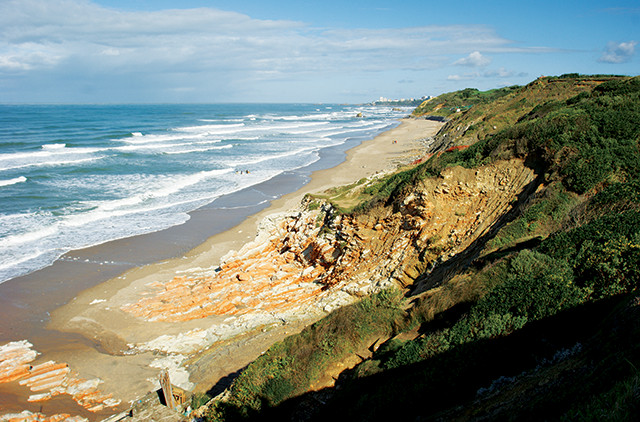
by Elizabeth Goldbaum Thursday, April 21, 2016

In sedimentary rock near Bidart, France, scientists found high levels of mercury associated with the eruption of the massive Deccan Traps flood basalts about 66 million years ago. Credit: Eric Font.
The end-Cretaceous extinction, known for finishing off the last dinosaurs about 66 million years ago, often evokes scenes of a large asteroid hurtling toward Earth. However, new evidence supports a growing consensus that the massive bolide wasn’t the only hazard that life on Earth had to contend with: A prolonged bout of major volcanic eruptions was also spewing climate-altering gases and other emissions such as mercury into the atmosphere.
The most intense pulse of volcanism unleashed about 1 million cubic kilometers of lava onto the Indian subcontinent, forming a large igneous province called the Deccan Traps, the solidified remains of which today still cover roughly half a million square kilometers. Although the main phase of Deccan eruptions is thought to have bookended the extinction event, starting about 250,000 years before and ending about 500,000 years after it, the lavas themselves hold little evidence of a massive die-off. So, to investigate links between the volcanism and the mass extinction, Eric Font, a geophysicist at the University of Lisbon in Portugal and lead author of a new study in Geology, and colleagues looked for evidence in sedimentary rocks thousands of kilometers away.
In part of an outcrop of sedimentary rocks near Bidart on the Atlantic coast of France, the team found high levels of volcanic mercury, more than two orders of magnitude higher than background levels elsewhere in the rock. The Bidart outcrop consists of fine-grained sediments that accumulated slowly on the ocean floor before, during and after the end-Cretaceous extinction. As the sediments settled through the water, they incorporated mercury likely unleashed by the Deccan eruptions, Font says.
Gaseous mercury boils out of magma as it reaches Earth’s surface. The element can then circulate in the atmosphere for a couple of years before settling back to the surface and becoming incorporated into sediments on land and in the ocean, explains David Pyle, a volcanologist at the University of Oxford in England who was not involved with the study. But other processes can cause mercury to accumulate in sediments as well.
To check whether the mercury anomaly was indeed tied to the Deccan eruptions, Font and his colleagues compared the concentrations of mercury at Bidart to levels of organic matter in the same rock. Typically, sediments with a lot of mercury also have a lot of organic matter because, as mercury enters the ocean as a result of natural weathering and erosion processes on land, organic matter in the water binds to it and carries it to the ocean floor. However, Font and his team found that their sediments had a lot of mercury but little organic matter. “This suggests that this mercury is not linked to organic matter scavenging, but, rather, results from higher input of atmospheric mercury from volcanic — Deccan — emissions,” Font says.
The rocks also recorded direct evidence of the mass extinction, he says, such as declining populations of planktic foraminifera below and at the end-Cretaceous boundary probably due to ocean acidification caused by large emissions of carbon dioxide and sulfur gases from the Deccan Traps eruptions. Mercury, though toxic itself, is not thought to have contributed substantially to the extinction event, but finding the spike of volcanic mercury amid the record of declining foraminifera allowed the team “to precisely locate the time at which the Deccan Traps had an impact on the biosphere,” Font says.
With this work, “we can link the mercury signal of the main pulse of volcanic activity … into the sedimentary context, where we can also measure changes in species” like the planktic foraminifera, Pyle says. Research looking at mercury as an indicator of volcanism has been progressing over the last two or three years, Pyle says, and this study is an important demonstration of the element’s potential to help constrain the cause-and-effect relationship between the Deccan Traps and end-Cretaceous extinction, while still maintaining an important role for the Chicxulub impact.
Indeed, the massive Chicxulub impactor that smacked into Mexico’s Yucatán Peninsula may have accelerated ongoing Deccan Trap volcanism, leading to increased emissions that would have been deadlier for life, says Paul Renne, a geochronologist at the Berkeley Geochronology Center who was not involved in the study.
Pyle and Font agree that both Deccan volcanism and an extraterrestrial impactor probably combined to cause the extinction. “There is no more doubt that the Deccan eruptions, plus the impact, plus the Cretaceous-Paleogene extinction all occurred together within a short [amount of] geologic time,” Font says.
The impact may have been “the straw that broke the camel’s back,” Pyle says.
Beyond pinning down the extinction’s triggers and timing, researchers continue to work on understanding exactly how the environmental perturbations wrought by the volcanism and impact actually caused mass die-offs by figuring out which species survived and which didn’t. “Once you understand what habitats and ecological niches were most affected, you can start to really get after the specifics of the mechanisms that caused the extinction,” Renne says. “That’s the real frontier.”
© 2008-2021. All rights reserved. Any copying, redistribution or retransmission of any of the contents of this service without the expressed written permission of the American Geosciences Institute is expressly prohibited. Click here for all copyright requests.